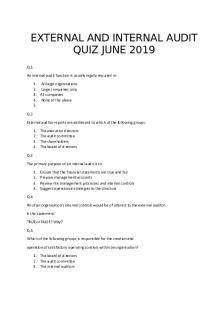Internal and external constraint PDF

| Title | Internal and external constraint |
|---|---|
| Author | Colton Brown |
| Course | Intro to International Business |
| Institution | Union University |
| Pages | 3 |
| File Size | 48.9 KB |
| File Type | |
| Total Downloads | 16 |
| Total Views | 158 |
Summary
tim tam thank you mam ohhhhhhh yeHHHH....
Description
Colton Brown Introduction to Philosophy Dr. Nell Senter 07/02/16 Internal and External Constraints on Your Freedom. External constraints are those imposed by your environment and your circumstances. For example, external constraint can be a variety of factors including: a parent telling you to pick up your room, police officer telling you to slow down, or something that impacts and forces you to make the choice that is not really of your own. Many times in our lives we make choices that are not of our own free will because of the influences of others. An example in my life of an external constraint was when I was diagnosed with a brain tumor. When I was fifteen, I took a large hit in football. When I was hit, I felt very tired and confused, so I went to the ER and they performed a CT scan. The CT scan showed a spot on my brain. Afterwards, my doctor sent me to Vanderbilt to acquire a MRI on my brain. The result of the MRI showed I had a tumor on the surface of the brain. At my appointment with the neurosurgeon/neurologist, my external constraint was present, the tumor. The neurosurgeon said that I had to have surgery. The neurosurgeon told me that, because of the tumor and the way it behaves, the tumor would secrete cerebrospinal fluid and put pressure on the major artery next to the tumor, and if I did not have the surgery, that it would cause an aneurism that would be fatal. I obviously had to take the surgery and remove the tumor if I wanted to live. The constraint was that I had to remove the tumor or my life would be in danger. The only way we can eliminate external constraint on our freedom is to remove the constraint. For myself, I had to remove the tumor in order to gain my freedom, but for others, it
could be removing an abusive partner, quitting a job, or moving away in order to obtain back their freedom. Internal constraints involve limitations to our autonomy that we impose on ourselves. These constraints could be addiction, obsession, jealousy, depression, or fears. These constraints limit your freedom but are not from someone else; these are from your own mind. An example for internal constraint would be my mother’s depression. My mother was a very influential and successful business woman in her area for years. However, the emotional abuse from her mother and the stress from her job resulted in depression. She could not handle the job anymore and had to quit. The depression has changed her life drastically. All of the things that she did actively before suddenly stopped. She would cry all the time. She would never leave the house. She wouldn’t clean after herself or even make herself food. The depression took her from an active happy lifestyle to a reduced home bound lifestyle. The depression was her constraint and it lifted her life drastically. The depression took away her freedom to live her life the way she wanted too. Internal constraints are much harder to remove than an external constraint. It takes identification of what the constraint is to determine and ask yourself, “what can I do now?” or “How can I change this?” When this constraint is identified is when the process of change or removal can happen. For my mother, she needed to identify that her life was turning for the worse because of the depression. She needed to find that her depression is taking away her freedom and that it needed to change. I very much believe that we are always free. Even in the ways we are constrained, we still have freedom. We can take what we are given and change it to a positive. For myself, I use that constraint as a tool to help comfort others suffering from tumors and cancers. For my mother, she
can now help other woman who have depression. As Frankl said, “one way we are Always free is in the attitude we take toward our circumstances, even if we cannot change them.” The freedom that we always have is attitude and no matter the constraint your attitude can help overcome it and you can be free....
Similar Free PDFs

Internal and external constraint
- 3 Pages

Internal vs. External Forces
- 2 Pages

Internal Law Vs External Law
- 10 Pages
Popular Institutions
- Tinajero National High School - Annex
- Politeknik Caltex Riau
- Yokohama City University
- SGT University
- University of Al-Qadisiyah
- Divine Word College of Vigan
- Techniek College Rotterdam
- Universidade de Santiago
- Universiti Teknologi MARA Cawangan Johor Kampus Pasir Gudang
- Poltekkes Kemenkes Yogyakarta
- Baguio City National High School
- Colegio san marcos
- preparatoria uno
- Centro de Bachillerato Tecnológico Industrial y de Servicios No. 107
- Dalian Maritime University
- Quang Trung Secondary School
- Colegio Tecnológico en Informática
- Corporación Regional de Educación Superior
- Grupo CEDVA
- Dar Al Uloom University
- Centro de Estudios Preuniversitarios de la Universidad Nacional de Ingeniería
- 上智大学
- Aakash International School, Nuna Majara
- San Felipe Neri Catholic School
- Kang Chiao International School - New Taipei City
- Misamis Occidental National High School
- Institución Educativa Escuela Normal Juan Ladrilleros
- Kolehiyo ng Pantukan
- Batanes State College
- Instituto Continental
- Sekolah Menengah Kejuruan Kesehatan Kaltara (Tarakan)
- Colegio de La Inmaculada Concepcion - Cebu












